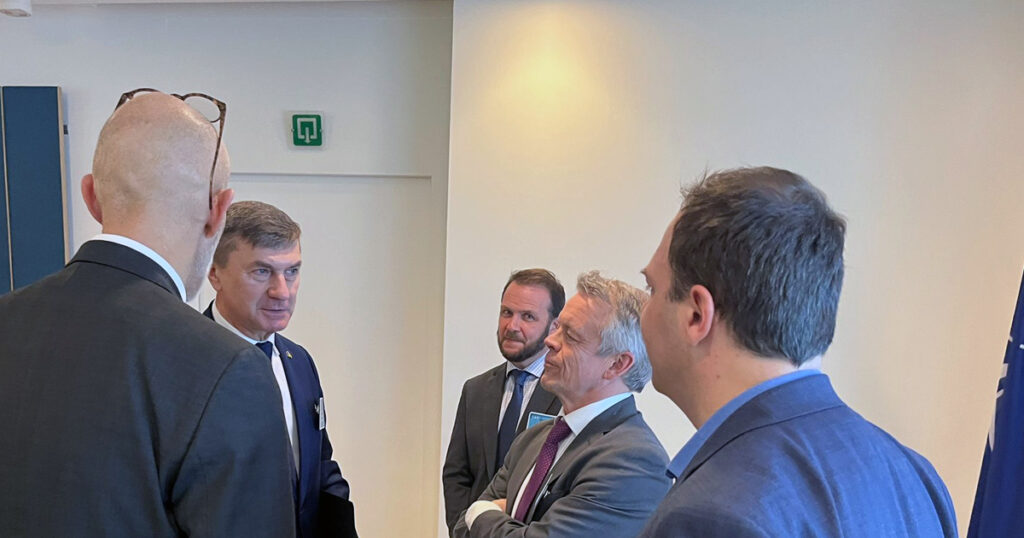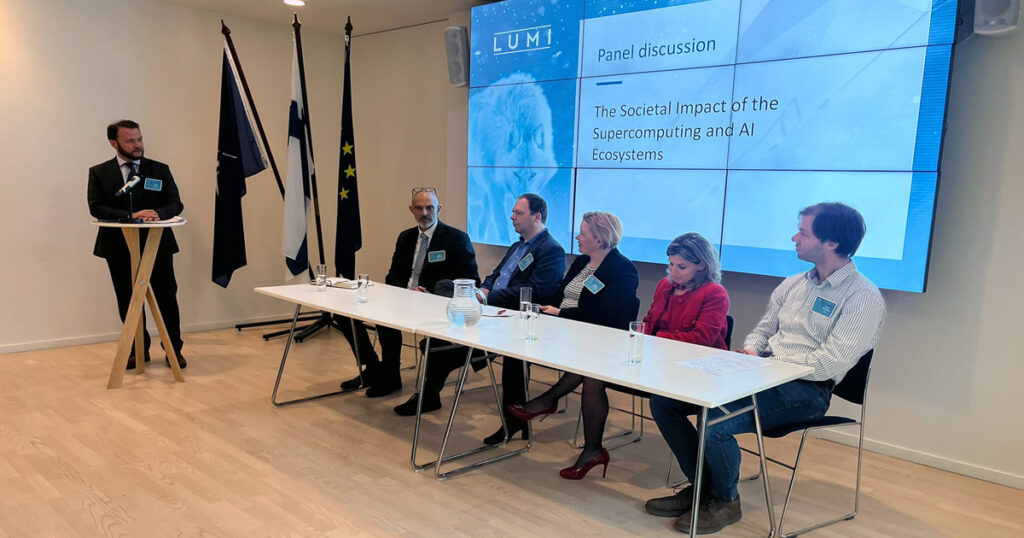Excitement about supercomputing at the heart of Europe: LUMI consortium event in Brussels on 5 March
“We need to be more encouraged, passionate in Europe, about what we can really do with our supercomputers, and we need to broaden the community,” said Margrethe Vestager, Executive Vice-President of the European Commission responsible for digital policy, when speaking at the LUMI consortium event on supercomputing and AI ecosystems, organised in Brussels on 5 March 2024. Excitement and human-centricity became key themes of the event that filled the conference room of Finland’s Permanent Representation to the EU with an enthusiastic crowd and a vibrant atmosphere.
Margrethe Vestager praised LUMI for sparking some of the much-needed excitement around supercomputing by enabling RDI projects that would be out of reach for European researchers without LUMI’s exceptional computing power, such as development of digital twin technologies. Vestager also raised the need for engaging broader communities in leveraging European supercomputing capacities, to reap their full potential.
The “excitement factor” was also brought up by Irina Sandu, who leads the Destination Earth Service at the European Centre for Medium-Range Weather Forecasts and therefore has first-hand experience with a particularly exciting LUMI use case. Destination Earth uses LUMI to develop digital twins of the Earth, a game-changing initiative for climate research and impactful climate action.

New business and new technologies
In addition to academia and policymakers, supercomputers are a key source of value creation for business as well. One example of this is Matgenix, a young Belgian company using LUMI to develop services related to materials discovery and design. “LUMI’s computing capacity allows us to simulate the use of various materials without having to test them in practice which saves a lot of time in the process of developing new materials”, said David Waroquiers, CEO and co-founder of Matgenix, who also spoke at the event. The potential societal impact of supercomputing for business is huge, transforming business models, processes and product development. Supercomputing is the key enabler of data economy.
Another exciting aspect of supercomputers like LUMI is their role as a platform for developing AI and quantum technologies, which are critical for EU’s competitiveness. This was discussed at length by Andrus Ansip, former Commission Vice-President and Commissioner for the Digital Single Market and current Member of the European Parliament. He pointed out the role of supercomputing in the development of Large Language Models and Generative AI and concluded: “With joint acquisitions of world-class supercomputers like LUMI, EuroHPC Joint Undertaking can really put Europe on the AI map.”

Quantum perspective was provided by Branislav Jansík, Supercomputing Services Director of IT4Innovations National Supercomputing Center, who is working on the LUMI-Q project that will acquire one of the first EuroHPC quantum computers to be located in Ostrava, Czechia, and connected to LUMI in Finland: “Quantum computers are – not now nor in the foreseeable future – stand-alone technologies but require cooperation with classical supercomputers. LUMI is a fantastic development platform for quantum and hybrid computing.”
It’s all about people
As excitement ultimately stems from people, another key theme of the event was human-centricity. People and competencies are also a necessity in creating value out of technology. The skills for both development and application of technology in all domains are critical. “Even the finest ecosystem of data, supercomputing and AI capacities is incomplete without the competent and innovative people that really bring the ecosystem to life and understand how to create value out of it”, said Tuuli-Maaria Aalto, Finland’s Deputy Permanent Representative to the EU. This was echoed by Niklas Blomberg, Executive Director of Innovative Health Initiative: “To get value out of supercomputing and AI infrastructures, you need people. Anyone can purchase hardware – the key question is how to build the ecosystem around it.”
Particular emphasis was put on equipping people with the necessary competencies for innovative use of supercomputing and AI. Despite education being a Member State competence, MEP Miapetra Kumpula-Natri called for EU action on competence development, in particular to boost women’s participation in supercomputing and AI ecosystems. Liviu Stirbat, Head of Unit on Industry 5.0 & AI in Science at DG RTD of the European Commission, added another aspect to human-centricity by bringing up Europe’s role as a driver of human-centric and ethical AI, something that may also help attract more talent to Europe. He also underlined the importance of user-centricity in developing supercomputing systems. In the context of RDI, this means that the needs of research and researchers have to be taken into account when developing research infrastructures, such as EuroHPC supercomputers.
It was also made clear that people must indeed be discussed in the plural. No one can achieve much on their own, so cooperation is key for developing state-of-the-art supercomputing and AI ecosystems. Rafał Duczmal, Chair of the Governing Board of EuroHPC Joint Undertaking, brought up the advantages of pooling European resources for ecosystem development while also discussing cooperation opportunities beyond Europe’s borders: “European ecosystem development must have a global aspect to ensure availability of best possible technologies and to develop competences together with like-minded partners from all over the world.”

Data at the heart of the ecosystem
The event also focused on elaborating on the concept of an ecosystem and the importance of developing data, supercomputing and AI infrastructures and competencies in convergence. “To create successful ecosystems, we must build bridges between supercomputing, AI and data communities, and invest in skills,” concluded Cécile Huet, Head of Unit on Robotics and Artificial Intelligence Innovation and Excellence at DG CNECT of the European Commission.
The central role of data in the ecosystem as the raw material of supercomputing and AI was also emphasised. “No data, no party. Well-managed high-quality data is crucial for data-driven RDI and AI development. Without it, it’s ‘garbage in, garbage out’”, said Hilary Hanahoe, Secretary-General of the Research Data Alliance. MEP Kumpula-Natri also referred to the importance of data for any current and future research and innovation activities, likening the opportunities opened by EU data regulation and data spaces to apples on a tree that must be caught by “baskets,” i.e. competent individuals and companies, before they fall on the ground: “We are shaking the apple tree, but if we don’t have the baskets under the tree, we get nothing.”

Let’s keep it green and collaborative!
In addition to praising LUMI’s ability to create excitement around supercomputing, Margrethe Vestager also thanked LUMI for showing the way when it comes to green computing. This was echoed by Minna Palmroth, Professor in Computational Space Physics at Helsinki University, who saw sustainable research infrastructures as a necessity for future scientific discovery: “High energy consumption of digital research infrastructures must not be used as an excuse to limit research. We must find other ways to reduce their negative climate impact in order to be able to continue scientific discovery, inform policymaking and, ultimately, improve the life of citizens.”
In short, the event was filled with insightful and inspiring discussions and hopefully left the participants excited to continue exploring the opportunities of supercomputing and AI ecosystems and developing them as holistic and collaborative efforts. As CSC’s Managing Director Kimmo Koski put it in his closing words: “When we work together to boost competence building through joint investments in supercomputing and AI capacities, it creates more talent and skills all across Europe, and everybody wins.”
Author: Satu Tuomikorpi, Senior Policy Specialist, CSC – IT Center for Science
Images: CSC – IT Center for Science